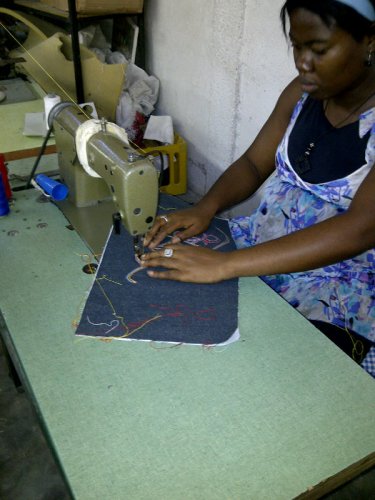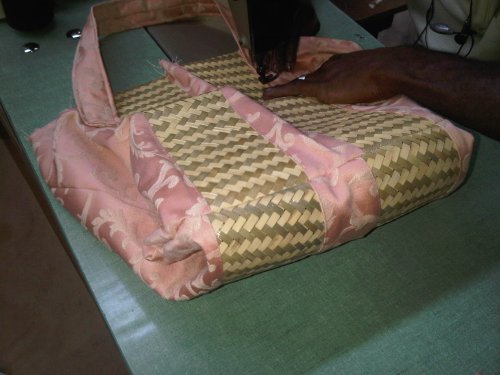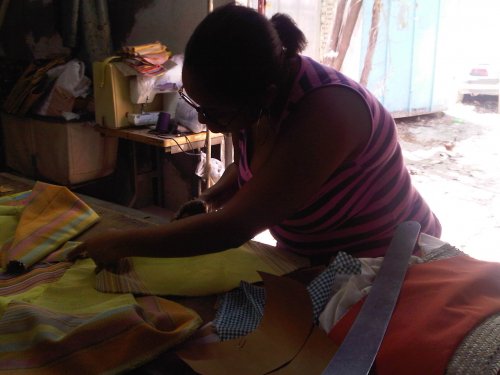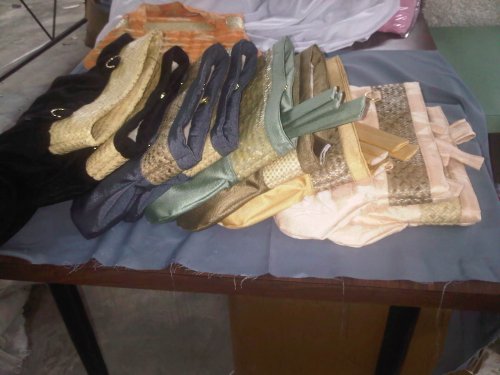Posted on October 28, 2013
CapraCare – A New Generation of Thinking and Leadership
|
|
In 2011, we featured CapraCare in our “conversations” segment and we must say that this nonprofit organization has tremendously evolved since the last time we interviewed the Founder, Jean Pierre-Louis. We are amazed of their accomplishments, their strong leadership in the community of Fonfrede, and their culture that upholds team work and advanced learning to create a new generation of leaders in the community of Fonfrede.
Why are we featuring CapraCare for a second time? It is an organization that is thriving with a strong foundation, like-minded individuals that say yes to change, yes to commitment and yes to making a difference. CapraCare is the sought-after community resource for the residents of Fonfrede as they envision to expanding their roots in other areas of Haiti. Their last mission trip in August 2013 led to more apparent results. Nothing is wasted in CapraCare. Every member, every team is valued for their efforts and contribution. Their mission focuses on community health, education and leadership so the people they are guiding can help themselves. The latter can make a huge and lasting impact in any community because education lasts forever.
The Founder, Jean Pierre-Louis a steadfast leader, candidly takes us on a personal journey that is riveting, empowering and inspiring. His legacy as he quoted in this interview is to create a “Haitian organization that is sustainable, viable, honest that provides opportunities for jobs and enhances the quality of life for the people of Haiti.” It is a fantastic read worth of sharing with your friends, family, children, colleagues & others. The essence of this interview covers different facets as you look into the roadmap of their amazing progression since they started in 2009, their values, the meaning behind the name of CapraCare, their mission trip and certainly the visionary behind the CapraCare organization.
We invite you to support their cause and their upcoming events in 2014. CapraCare is also listed under our Healthcare Education and Local/NGO sections. Inquiries about donations, volunteerism and partnerships should be addressed to info@capracare.org.
Thanks to Jean Pierre-Louis for this amazing opportunity and a heart-to-heart conversation!
Dahla
|
The Organization.
Haiti1Stop: In the past 3 years, since the inception of CapraCare in 2009, how has the organization evolve as an entity? What have you accomplished with CapraCare since our last interview?
Jean Pierre: We created several key partnerships with other organizations in Haiti to ensure support and enhance the viability of the organization. Since our last interview, we have accomplished the following:
|
· CapraCare received funding support from a major Foundation to assist with transportation needs for our staff.
· CapraCare is now the clinical site for the City University of New York’s doctoral nursing program for candidates to conduct medical field services in Haiti.
· CapraCare’s Community Health Workers (CHWs) are certified by the Haitian Ministry of Public Health and Population (MSPP) to provide services to their community in Haiti.
· The organization has provided services to over 10,500 of our Haitians constituents.
|
Haiti1Stop: How was the name “CapraCare” chosen for the organization? Is there a story behind the name?
Jean Pierre: The word “capra” comes from the word “capraesque” — evocative of the movies of Frank Capra who was an Italian-born American film director; who immigrated to the United States with his family in 1903. In his movies, he often promoted the positive social effects of individual acts of courage.
I also adopted the “capra” because my zodiac sign is Capricorn and I love the definition of the sign. I think the sign embodies who I am as a person; the Capricorn is all about hard work, ambitious, determined, practical, and extremely dedicated. I added the word, “care”, because of my compassion for people and the mission that the organization would be embarking – hence, CapraCare, with a self-definition to mean “an act of courage.”
Haiti1Stop: We want people to know more about your organization and its great work. Can you tell us what inspired you to found the organization? Is it your love for humanitarian causes? Is it your childhood connection?
Jean Pierre: I found the organization as a result of a combination of things:
|
· Discrimination of the 1990’s that Haitians were facing in New York including myself at the school playground. For example, in the 1990’s Haitians were being called boat people; non-Haitian kids teasing me and my friends in elementary school telling us that our parents were “Haitian booty scratchers” (a reference for those that work in the nursing homes or with the home elderly who are homebound).
· The needs and poverty that I remember that I left back home in my community motivated me — the gross inadequacies of medical and preventive health services in Haiti.
· I love the humanitarian causes but I think it’s a drive to empower the have not and put them in a position to help themselves, then we can bring about a positive change so they can help themselves.
|
Haiti1Stop: In 5 words, give us a glimpse of CapraCare’s values so people can get a sense of what the organization stands for.
Jean Pierre: Passion | Purpose | Intelligence | Discipline | Dedication.
These are some of the values that we hold to build from the ground-up! Honesty plays a big part of our foundation.
The Mission Trip. The Projects
Haiti1Stop: Your non-profit organization takes on different projects for the betterment of the Fonfrede community. One of those projects is organizing a mission trip to Haiti at least once a year. What do you hope your volunteers will take away when participating in those mission trips?
Jean Pierre: I hope that they will be inspired to continue supporting the community of Fonfrede longer than their short-term mission. I also hope that they learned as much from the people as the people learned from them.
Haiti1Stop: Your last mission trip to Haiti took place in August 2013. a) How long did the trip last?
Jean Pierre: The mission was 1 week.
Haiti1Stop: b) What was the biggest highlight of your trip?
Jean Pierre: We conducted a complete analysis of each of our core programs and completed a few partnerships with other Les Cayes’s organizations.
Haiti1Stop: c) What was the hardest thing you faced on your trip?
Jean Pierre: The hardest thing for us was time poverty because we felt we wanted to do more but we did not have enough time. However, we were very happy that we were able to accomplish all our objectives during the trip. But more importantly, we left a core team in place to provide ongoing service to the community. And, that is always more important to us – to empower the core Haiti team to do the on the groundwork.
Haiti1Stop: d) Was there anything funny that happened during the trip that you would want to share with us?
Jean Pierre: I wouldn’t say funny. We had an amazing all team retreat where the entire organization took a day to have fun at the beach and got a chance to enjoy and get to know each other outside of the office.
Haiti1Stop: What would be the best 10 memorable things that you and your staff remember about your mission trip in Haiti?
|
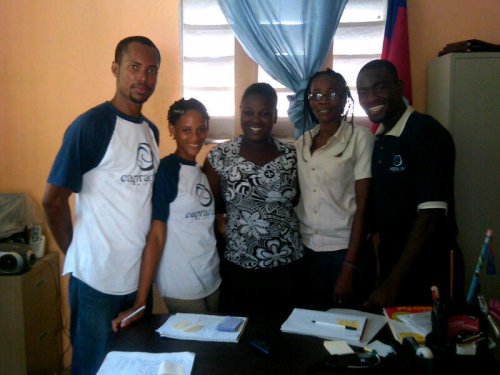
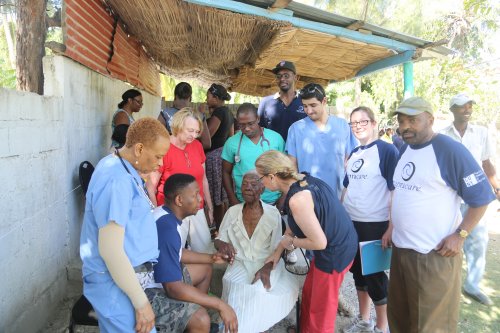
|
Jean Pierre:
1. Our Caribe bus broke down in the middle of the roads at the Dominican board right before we reached the Haiti board during the Haiti relief efforts.
2. The inauguration of our office in Haiti.
3. Providing mental health support for families affected by the earthquake.
4. Providing physical therapy and mental health support to people who lost limbs during the earthquake.
5. Providing dental care services to over 100 kids in 2 days.
6. Providing medical services to over 1200 people in 5 days of work.
7. A visit from CUNY’s top executives.
8. Being in Haiti to see 20 CapraCare’s staff receive their certificates as certified community health workers.
9. Delivering the Haiti office’s first office stationery.
10. The U.S medical team conducting a physical examination on my 113 year old grandmother at the CapraCare office.
|
Haiti1Stop: For people who would want to volunteer in your next mission trip, can you illustrate a typical day of a CapraCare volunteer in Haiti?
Jean Pierre:
· 8am – Breakfast
· 9am – 1pm Work
· 1pm – 2pm Lunch
· 2pm – 5pm Work
· Downtime to know the city, learn the community, eat fresh fruits or · sugarcane, etc.
· 8pm – Dinner/Super/Stargazing or just relaxing at the guest-house until bedtime around 10pm.
Haiti1Stop: Reflection is an essential element that allows anyone to look back and learned from their experiences. What do you think resonate with your volunteers in terms of learning about the community and projects on a short mission trip? Is there a connection with the people they serve in Fonfrede?
Jean Pierre: Absolutely! How hard the CapraCare Haiti staff works always amazes the U.S volunteers. They are impressed at how the people of the community are so genuine, respectful, and grateful for the help they received from the U.S staff.
Haiti1Stop: CapraCare is known to have a huge focus on mental health education and professional development. Tell us how the community in Fonfrede responded to those life skills workshops.
Jean Pierre: They are very receptive to the mental education and support group. The life skills workshops are geared towards the children. We are working on formalizing workshops for the adults.
Haiti1Stop: In our last interview, you mentioned that approximately 1500 people per year were being served by CapraCare. Has the number of people you are now serving in the community increased?
Jean Pierre: Things have drastically changed! Since our last interview in December 2011, we have served over 10,500 people in the community.
Haiti1Stop: We understand that you are hands-on on those core training workshops in Fonfrede. Can you elaborate on the types of workshops and courses being offered and how they are paving the way for a brighter future in the community?
Jean Pierre: We have workshops in the health education for the schools and larger community, life skills for the youth, and professional workshops for the staff.
Haiti1Stop: Now, that the community of Fonfrede has embraced CapraCare with open arms. Give us a glimpse of how the community has changed in terms of leadership, social/health issues and empowerment.
Jean Pierre:
· The community leaders have embraced the organization and helped us to raise awareness.
· We have created a Community Advisory Board to help direct our work and the needs of the community.
· We have created a mutual collaborative linkage with the local emergency center and CapraCare.
· Our health education and prevention workshops are well attended by the community.
Haiti1Stop: What do you consider to be the top 4 accomplishments of your last trip in Haiti if you can summarize it? And, why do you consider them essential?
Jean Pierre:
|
1. We conducted a SWOT (Strength, Weakness, Opportunity, Threat) analysis of all five core programs; we taught the staff how to also conduct the SWOT as well.
2. We implemented our sustainability plan for each core program.
3. We created two new partnerships with two larger NGO’s operating in nearby surrounding communities.
4. We are currently working on an IT database to capture all our services and outcome.
|
The Founder. The Visionary. The Family man.
Haiti1Stop: Why did you choose Fonfrede as the community to be serving and not other areas of Haiti?
Jean Pierre: I was born in the community and my family has a long honest history there; my 113 year-old grandmother is still living there.
Haiti1Stop: Achieving success is a collaborative effort that most people undermine. However, you are a positive leader that embraces collaboration and we are curious to know what other types of partnerships are you looking forward to achieve?
Jean Pierre: We are looking to collaborate with more organizations that are focused on global health, and to collaborate with universities seeking to have their students do field work for their internships, masters paper, dissertations, research, etc.
Haiti1Stop: Every organization has a board, team members & leaders that contribute to its success. In 3 words, how would you describe the behind scenes atmosphere of a team meeting?
Jean Pierre: Participatory | Engaging | Lively
Haiti1Stop: A great leader must carry different hats and be accepting by the people they serve. You are such an approachable person, how would you describe your style of leadership?
Jean Pierre: I’m team oriented to accomplish goals; easy going; work first, play later. However, I am not afraid to take on a task alone to get it done. I keep a good balance of when to be democratic and when to be autonomous in my approach.
Haiti1Stop: What would be the best advice would you give to someone who’s looking up to you and want to follow your steps?
Jean Pierre: You must have heart, courage, and be relentless at pursing your mission; always look for small victories; otherwise, you will not last.
Haiti1Stop: You are a family man who is passionate about your work and organization. Doing what you do can become exhausting and not everyone has your type of drive, your determination. How do you balance work and family life? And, where do you get your source of energy?
Jean Pierre: I am very lucky to have a very supportive family that understands the sacrifices that my work takes in order for those who are less fortunate to have a chance or hope for a better future in Haiti.
To support my health, I go to the gym very early in the morning for four days a week. My motivation is that I am obligated to give back to my community because I represent them.
Haiti1Stop: Preparing for a mission trip requires great team, great leadership and good standing strategic planning among the many. Can you tell us what has been different about preparing for the 2013 trip compared to the previous one?
Jean Pierre: Our February 2013 trip required a lot more coordinating, organizing, and preparing because our group was much bigger than usual. We were organizing a medical mission which would also include mental health training and research. The team included the following people: High level City of University of New York executives, City University of New York Doctoral Nursing’s students, Nurse practitioners, Mental health professionals.
Haiti1Stop: Give us your best life quote that summarizes your challenges, triumphs and expectations?
Jean Pierre: It’s not how you Start, it’s how you Finish!
The Future.
Haiti1Stop: As a non-profit organization, it is the norm to hold fundraising events. What future events should we look forward to this end of the year and in 2014?
Jean Pierre: We will host 2 major events in 2014:
|
1. CapraCare’s 4th annual “Show Your Love for Haiti,” to commemorate the Haiti earthquake of 2010.
2. The 5th anniversary celebration for CapraCare which will be held sometimes in June 2014.
|
Haiti1Stop: Are there projects in the works for CapraCare that you wish to announce to our audience?
Jean Pierre: As of right now, we will look to do another medical mission and a very intensive train-the-trainer with our core trainers in Haiti.
We will also be focusing on applying for grants to get some our current projects funded.
Haiti1Stop: Have you ever thought of opening a CapraCare clinic in Fonfrede?
Jean Pierre: We now actually have a clinic in Fonfrede. We are able to provide both medical services and medication to folks.
Haiti1Stop: What is the legacy you wish to leave with CapraCare?
Jean Pierre: That I was able to create a Haitian organization that is sustainable, viable, and honest; to provide opportunities for jobs, and enhance the quality of life for the people of Haiti.
Haiti1Stop: With the Haitian Government’s efforts to promote tourism in Haiti, what insights do you have on the subject? And, would you be open to organize an ecotourism tour as part of CapraCare’s future mission trip so people can discover more about Fonfrede’s livelihood.
Jean Pierre: I am fully aware of the tourism efforts in parts of the country especially in Jacmel. Earlier this year, I was in a conference where the Prime Minister of Haiti, Laurent Lamothe, highlighted some efforts but they still have much more ways to go before seeing a profit on their returns. I have a friend that takes college students during spring break to Haiti and that has been a good draw every year.
These are the top 15 places someone suggests to visit in Haiti that I know:
1. Jacmel
2. Labadee
3. Petion-Ville
4. Kenscoff
5. Champs-de-Mars (National Museum)
6. Port Salut
7. Gelee
8. Lake Azuei
9. Mole Saint-Nicolas
10. Bassin Bleu
11. Jeremie
12. Saut D’eau
13. Ile-a-Vache
14. Forest-des-Pins
15. Belle Anse
Fonfrede has a very nice history and is the birthplace of President Antoine Simon. He was Haiti’s President from 1908-1911.
Haiti1Stop: For anyone interested in supporting CapraCare’s projects in Haiti, what should they do? How can they contact you?
Jean Pierre: They can visit our website at www.capracare.org/get-involved or contact me directly at JeanPierreLouis@capracare.org . I also can be reached at (478) 227-7209
http://haiti1stop.com/blog/2013/10/28/capracare%e2%80%93a-new-generation-of-thinking-and-leadership/
Posted on October 16, 2012
Spotlight on Designer Nora David
|
|
When I first heard of Nora David at the IHDA event (Independent Handbag Designer Awards), I was elated to know she was a Haitian Accessory Designer and I immediately tweeted about it. She was one of the finalists in the “Most Socially Responsible Handbag” category and that was a great achievement. Soon enough, we briefly commented and proudly congratulated her in our blog on June 15, 2012.
We, at Haiti1Stop wanted to know more about this great designer, her style, her brand, her philosophy and her business acumen that no one has already unveiled. That prompted us to immediately get in touch with her for a great conversation and for a request of an interview. I must say that I was pleasantly honored to have spoken with her. It seemed that I’ve known her for a very long time based on personality and design background. My first call to her revealed a savvy woman who is witty, warm, real, eloquent, inquisitive, pleasant, natural, down to earth, friendly, decisive, and of course fashionable. She certainly captured my attention and I was ecstatic when she agreed to be featured onto Haiti1Stop “Conversations” segment.
After arduous work and patience, we can finally deliver to our readers an insightful and inspirational interview with Nora David that truly captured her essence as no one has done before. She truly delivered in our interview as she talks about her childhood, her family life, her design concept, her journey as a businesswoman/factory owner and her upcoming nonprofit organization; and we are honored to have such great opportunity. Her profile and her journey to being the designer that she is today will unequivocally be a teaching tool and an eye opener to youngsters, upcoming designers, professionals and business women. You will get a sense of who she is along with her vision.
Committed to her Haitian roots while giving back to her community, we are proud to feature Nora David in a different limelight. We welcome you to take on this journey of discovery as we present you the different facets of Nora David: the individual, the designer, the brand, the entrepreneur, the business woman and the philanthropist. We want you to enjoy reading each phase at your own pace and share it with your family, friends, colleagues and social media followers.
We encourage all of you to visit her website at http://collectionsxaragua.com and support her efforts in keeping the locals employed in her community, and sending her employees’ kids to school.
Thank you for such great interview Nora!
Dahla
|
The Woman. The Individual
Haiti1Stop: As women, we all are different creatures in the way we think, we create and deliver our passion to the world to make things happen. How do you define “YOU” as a woman? What are 5 adjectives that best describe you as a woman and as a designer?
Nora David: I think what defines me as a woman is the unconditional love I have for what I create. I would say that the best 5 adjectives that describe me as both woman and designer are: passionate, sensitive, patient, curious, simple.
Haiti1Stop: What is your motto in life?
Nora David: Don’t only go after what you need, go after what you want too. With only one life to live, you want to make the best out of it for yourself. There is nothing better than being proud of yourself (•‿•)
Haiti1Stop: How would you describe your childhood / upbringing in Haiti (give us a visionary picture in our minds)? Is there one thing that you are passionate about that you would like to share with us? Which subject did you enjoy the most while you were in school in Haiti?
Nora David: Today, I can say I had everything I needed when I was a child. The family ties are strong, went to one of the best schools, got a great education…When I look back, there is nothing that I would like to change…well maybe I would be more appreciative and stop complaining about everything hahahahaha
My favorite subjects were Mathematics, Physics and Chemistry.
Haiti1Stop: Do you have any siblings as talented as you are?
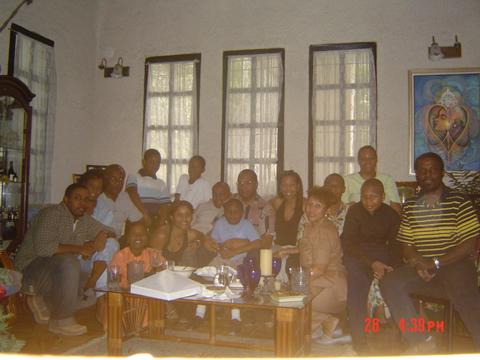
Family Picture
|
Nora David: Yes I believe we are all talented in our way. My younger sister enjoys drawing and she does it well; my younger brother is very naturally talented with graphic design and uses his talent to make some money while at university; and my older brother is my savior when it comes to change backgrounds, make websites and find any information related to Adobe software.
Haiti1Stop: You decided to settle in Haiti as a businesswoman, what is it about Haiti whether it is its arts, its culture, its scenic views, its lifestyle that inspires you the most as a child and as an adult? Can you say in one word what does Haiti represent to you?
Nora David: What inspire me about Haiti is the people; how they create with nothing. Yes Haiti has art, a beautiful culture; the views are out of this world, but everything lies in every single Haitian. To me, Haiti is Home.
Haiti1Stop: How early did your creativity surface? In which format did it surface whether in the form of drawing, painting, sewing or crafting? Was the passion innate in you to become an artist or designer?
Nora David: My creativity surfaced very early. It started with dressing up my dolls, then drawing and painting. Later my mother taught me how to sew. I remember in high school, I was designing outfits for my friends so they could look stunning and different to go to Heaven, a nightclub.
Haiti1Stop: Was attending design school, your first calling in life? If yes, did your parents inspire you into that path, especially having your mother as an accomplished businesswoman and designer and your father as an architect? If not, what was your first choice of study?
Nora David: Believe it or not, it wasn’t my first calling in life. Because I was good in Mathematics, I first thought of being an engineer. Then I was attracted to management. It’s only during my last year of school, that I decided the best thing for me would be to mix fashion and management! Best decision!
Haiti1Stop: At what age did you create your first artistic project? Do you still have it among your creative treasures? If yes, would you share with us what it was and submit a picture to us?
Nora David: My first artistic project was an abstract painting I made. I was 11 years old. I’d love to share it with you but unfortunately this painting is now in storage.
Haiti1Stop: Which factors influenced you to enroll in the Fashion Design School of Montreal located in Canada? And, why Canada and not the U.S. or France? How long have you lived in Haiti prior settling in Canada to pursue your studies?
Nora David: The reason why I chose Montreal was because it is one of the top fashion capitals. And it’s only 3 hours away from Haiti. The Fashion Design School of Montreal was also the only school offering exactly the program I was looking for, Fashion Management.
I’ve lived in Haiti for 19 years before going to Montreal…
Haiti1Stop: What inspired you in becoming a handbag designer and not a clothing designer first? Have you always had an affinity for handbags? How would you describe the similarities and differences in delivering a clothing line versus a handbag collection?
Nora David: It was a business decision. The investment was less to start with handbags than to do so with a clothing line. I do have an affinity for handbags, I can’t even count how many handbags I have! My creations are not limited to handbags though; I design clothes, jewelry and shoes too. I plan to have a full line.
Delivering a line, whether clothing or jewelry, has its challenge. I cannot create just for the fun of creating. I have to follow the “fashion rules”, the trends, the shapes, etc. The difference between clothing and handbag is that you get to play more with the handbag as you can add so many different accessories to it and mix the fabrics as you wish.
Haiti1Stop: What is the most valuable lesson you retained from your school age of design? How tedious was the program at the school? Did any professor influence you in a memorable way that captivated your love for design? Which elements of the handbag classes did you enjoy the most and / or help you shape your business?
Nora David: The most valuable lesson is the customer will or will not like your design. So you have to distance yourself from your creations and accept critics for the best.
I have to admit that if you are not made for this world, you won’t make it past the first year of school. It never never never ends, it’s never good enough. Inspiration is the key because you have to come up with something different in this saturated market..
The construction of garment and handbag is the key to your business. It’s how you put it together that makes a difference in visual and quality, thus different from the competition.
Haiti1Stop: Can you tell us if you have a designer in mind that you’ve always admired in the fashion industry? What is it about the designer or artist that is appealing to you?
Nora David: Yes, Gabrielle Coco Chanel. She was determined to rise from her humble origins. She was creative, took risks, and changed the way women dressed. Not to mention the little black dress and the bag that finally freed the women’s hands, the 2.55 (•‿•)
The Designer
Haiti1Stop: Does Nora David have a specific fashion style that she identifies the most?
Nora David: Yes, I do and this makes me remember that a friend of mine had told me one day that I am classically chic. I am a woman who loves her life and life in general. I am confident and assertive, and friends and family know that if they need help solving a problem, I am here for them. Therefore looking pulled-together at all times is a priority for me. That’s why I rely on classic, simple items that don’t require a lot of thought and have timeless style. To that classic look, I will add my touch of sophistication by wearing prints on prints, or a plus size outfit with a belt to give it that extra loose look, but take each piece I am wearing and you will see it’s a simple item.
Haiti1Stop: What does the word “DESIGN” mean to you? Do you see yourself as a trendsetter? Do you follow any international trends?
Nora David: Design is Create, let your inspiration take over and create. Yes, I do follow international trends for colors and shapes. But for trimmings and details, I design my own.
Haiti1Stop: What is your Designer tip of the day?
Nora David: Mismatch matches too. Try some prints on prints (•‿•)
Haiti1Stop: In designing a handbag, what is your most precious possession that you have to have in every design process (a tool, a notepad, a ritual etc…)? Is there such thing as a design mistake? Do you have a story to share with us about it?
Nora David: A notepad, a black pencil, color pencils…Yes, a design mistake is very common. When you design, sometimes you tend to forget about the technical, practical and doable. Hahaha yes, I do have a story. I designed a purse that everybody loved! It was so beautiful that I decided to make it the signature purse. I had forgotten one little thing: I designed the handles to be on the straw. Big mistake as the straw is not strong enough to hold the weight…
Haiti1Stop: Which elements about a handbag do you like the most? How many handbags do you own?
Nora David: I would say inside pockets and cellphone pockets. Well, I don’t know for sure but I believe around 100…
Haiti1Stop: What inspires you as a designer every day to think, breathe and create handbags?
Nora David: Periods of time, paintings…
Haiti1Stop: Creating a handbag demands a creative process from the inspiration, sketch, theme, color, shape and design, materials to be used leading to a story board. Can you share with us the journey of this process so we can envision your design space into creating a handbag?
Nora David: First, I would choose a theme. Following the color trends and staying within my theme, I would go fabric shopping. Then, I would put some Vangelis type of music, sit with my fabrics and start creating…
Haiti1Stop: As a creative artist, I hold on to the first projects I’ve ever done to set the tone for the next project. Do you do the same in keeping your first design projects or do you discard them especially if they are not of good quality? And, do you still have the 1st handbag you ever designed? If yes, would you share a picture or description of it with your fans and Haiti1Stop?
Nora David: I keep all my projects, good or bad. And yes, I still have the very first handbag I designed…

1st Handbag Design
|
Haiti1Stop: Can you describe to your fans the different styles of handbags that exist? What is your intake in selecting the perfect handbag? Should a person pay attention to their body structure to select a handbag?
Nora David: There are 20 styles of handbags. The most popular ones are the bucket which is a shoulder bag in a shape of a bucket, the tote which is a carry-all square bag, the clutch, the messenger bag which is a roomy bag with adjustable strap, the satchel which has a wide and flat bottom and short handles, the hobo which is a shoulder bag that dips in the center, the wallet, the backpack….
Yes, a person should pay attention to their body structure. Just like you try on clothes, you have to try on a purse. It has to fit and it has to be comfortable. Not every bag fits every body type either.
Haiti1Stop: Do you think a designer should be a great sketcher and / or patternmaker in order to launch their collection? Which qualities do you think a person should possess in starting a handbag collection?
Nora David: I do think you need to be a great sketcher, because the sketch is the beginning of everything. If the sketch is wrong, the chances of having the handbag right are slim. It is definitely a plus if you can make your own pattern. Sometimes the patternmaker might not see your vision and only you can make it.
To start a handbag collection, you need to know handbag construction, what components should go into the making of the handbag. It is a plus if you can make the first sample yourself, to find out there might be a problem or not.
Haiti1Stop: In the fashion / accessory world, who do you think might be your biggest competition or an inspiration to you and to the vision of your brand whether it is contemporary, futuristic?
Nora David: My biggest competition is the already well known brands. And they are also my inspiration as I would like to see my brand as popular.
Haiti1Stop: Would you share with us, which companies did you work as an independent designer after graduating from the Fashion School of Montreal? What are the most valuable lessons you’ve learned from working in those companies? Would you recommend an aspiring designer to work for a company or intern prior launching their own line?
Nora David: I would definitely recommend an aspiring designer to work for a company prior to launching their own line. First reason is you get to make contact with key people in the industry, whether it is supplier or potential client, and you get to learn from the inside how this industry really works.
Haiti1Stop: We think that all Haitian designers should support each other in such competitive industry and may the best win. So, how have you seen support from your fellow artists? If not, what would you wish for?
Nora David: I have to say that my generation is very supportive. We encourage each other a lot. I get support from other designers and they get support from me. I wish it was like that at all level…
Haiti1Stop: Some people in the fashion industry identify Haitian people as being crafters and not designers. And, those few Haitian designers that are doing well in their craft are not known to the public. How would you differentiate a crafter versus a designer? And, how can we break that stigma of being not as qualified of a designer for those who have doubts about us?
Nora David: Yes, they tend to see designers as crafters. But there is a difference. The designers create and the crafters execute. In my case I create the handbags but I don’t weave the straw, thus I am the designer. The people weaving the straw are the crafters.
That stigma can only be broken by us designers. We have to stop accepting people (mostly the foreigners) referring to us as crafters. We have to make sure they refer to us by what we are. If the media says “crafters” we have to contact them and have them correct it to “designers”. If a famous foreign designer introduces us as “crafters” we have to correct him/her and have him/her introduce us as “designers”…
Nora David’s Collections Xaragua. The Brand
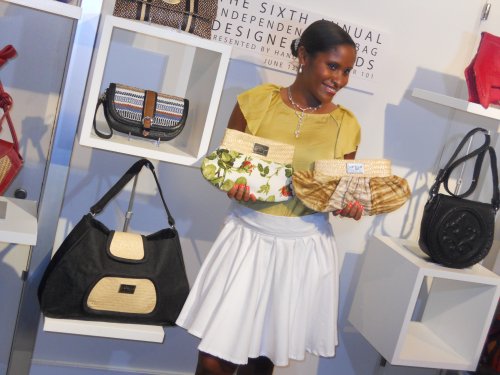
Nora at IHDA in 2012 with the purses
|
Haiti1Stop: We congratulate you again for bringing Collections Xaragua to our door steps. We are curious to know, how did you hear about the IHDA (Independent Handbag Designer Awards)? Are you planning to re-enter the competition any time soon?
Nora David: I was doing some research online about handbags and found their website. As I was browsing, I saw the contest and decided to participate. Yes, I am planning to enter the competition next year.
Haiti1Stop: What is the best way for people to know about your next event show?
Nora David: It would be through the social media, facebook, twitter @CXaragua and our website at www.collectionsxaragua.com.
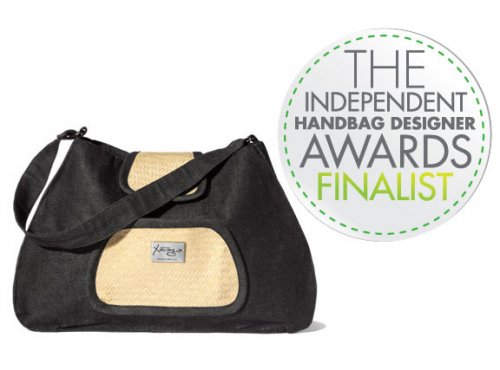
Adabelle bag
|
Haiti1Stop: You submitted the beautiful “Adabelle” style handbag to the IHDA? We want to know how did you select which handbag to submit to the competition? When did the “Adabelle” handbag make its debut?
Nora David: I selected Adabelle for the competition simply because I love this bag: very versatile for an everyday bag, big and strong enough to hold a laptop, cellphone front pocket for easy access, the flat bottom makes it easy to reach inside…
Adabelle made its debut for the Spring-Summer 2012 collection.
Haiti1Stop: When I attended the IHDA event, what struck me was the name of your collection: “Xaragua”. I find it to be strong, fitting, historical and meaningful. Congrats on the brand name!
Now, was the name Xaragua, your first choice of name for your collection? Or did you have a discussion about it prior of selecting such name? Would you share with us the story behind the name “Xaragua” for those who do not know of it?
Nora David: Yes, it was my first choice. I wanted a name that screams “Haiti” and also that I could relate too. Xaragua was the most popular chiefdom with a Woman as head of state. I want to make Collections Xaragua the most popular Haitian brand owned by a woman.
The origin of the brand name, Collections Xaragua, obviously comes from Haitian history. It is my way to pick every one’s curiosity so they can learn about Haiti, when it was called Hispaniola. Before the slaves were brought to the country, Haiti was a peaceful and beautiful country, inhabited by the natives (called Indians by Christopher Columbus). Xaragua was one of 5 and the most popular and strongest of the chiefdoms of Hispaniola, it was a chiefdom in which 2 of the most influential caciques were a brother and sister, Behecchio and Anacaona. Xaragua was in the southwest peninsula. They grew lots of cotton here and also in the cul de sac, north of where Port-au-Prince lies today. It was full of peaceful Tainos that were very peaceful but were killed due to trickery and hate.
Haiti1Stop: The brand name is very important to set a designer apart from many other brands. What is the best advice would you give an aspiring designer / artist on how to define their brand?
Nora David: You always gotta have a story behind your brand name. In my opinion this is what will keep you grounded and focus. The same way your story tells who you are as a person, the story of your brand will make your brand be what it is.
Haiti1Stop: For those people who do not know, when exactly did you officially launch your line? Why did you choose such date?
Nora David: I launched it on April 30th 2011 at the very first edition of Runway Haiti. It is not the date that I chose, but the event. I chose this event because Runway Haiti was a platform to gather all Haitian designers on a runway to promote our designs locally and internationally.
Haiti1Stop: How would describe the Xaragua collection style? Who is the customer that would wear your handbag? Do you listen to their feedback? And, where do most of your customers come from?
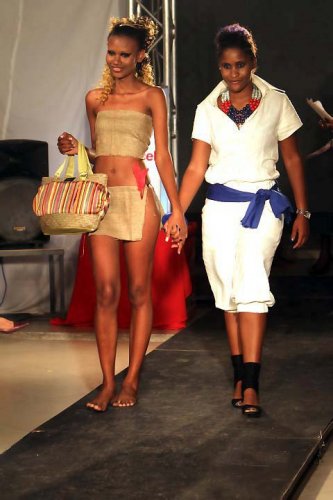
Collection Xaragua
|
Nora David: Collections Xaragua is a line of handbags consisting of unique shapes that are trendy and chic to go with every woman. The brand is a modern twist on the classic handbag with a combination of bright colors and palm straw; the signature of Collections Xaragua. The customers that will wear my handbag is a professional woman who chooses carefully her outfits and likes to make a statement by what she wears.
Yes, I do listen to their feedback, as this is what will help me satisfy them better and better and understand their needs. Most of my customers come from Haiti. Now that I just entered the Floridian market, I am starting to have a wider range of customers.
Haiti1Stop: You design different styles of handbags, each one with a special name. What inspires you from selecting those names for your handbags (like Selma, Yedda, Heloise, Rexana, Blanda, etc.) Does the name underline the style or the personality behind the handbag? And, which style do you like the best and why?
Nora David: Every name has a meaning that underlines the personality of the handbag. For example Selma means safe. The construction of Selma makes it easy for the holder to open the handbag, but difficult for someone else. Plus the bag is reinforced to support an up to 17” laptop. It’s the safest one in its category.
It’s hard for me to tell which one I like the best hahahaha. But, the Edina, which is the crossbody bag is one of my favorites. It carries everything I need, has an easy access front pocket and my hands are free! I carry it all the time!
Haiti1Stop: What is the retail price of your handbag? Do you also sell wholesale in case there might be people interested in carrying your line in their stores? What is the method of payment that you accept?
Nora David: My handbags vary between US$35 and US$135. Yes, I do sell wholesale and they can contact me via my website or by email at info@collectionsxaragua.com.
I accept paypal, direct deposit, cash.
Haiti1Stop: Are there any stores in Haiti that carry your collection? If yes, which ones are they? And, do you intend to open a store in Montreal in the future?
Nora David: For now there are no stores in Haiti carrying my collection but It will happen very soon, before the end of the year (•‿•)
For now, I have no plans to open a store. I’d love to see my bags in different existing stores.
Haiti1Stop: Currently, your website does not allow online purchasing, how can a person from overseas purchase your handbag? Are you able to deliver your handbags to overseas? If yes, to which countries?
Nora David: Yes, the person can contact me via the website and mention which handbag she would like to purchase and we go on with the transaction via paypal. Yes, we can ship anywhere, shipping paid by the customer.
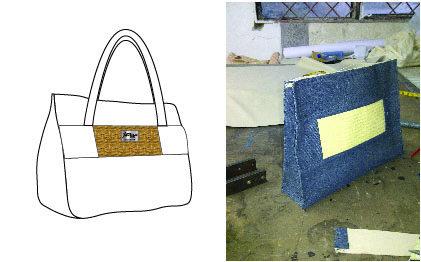
From Drawing to Sample
|
Haiti1Stop: Each designer has something that elevates their heart rate and drives them to finish their product. Which one is it for you: the sketching (using a pen or a computer), the selection of materials or the finished product?
Nora David: It’s the finished product. Mostly when from the start I can see it will look exactly how I had it in mind…
Haiti1Stop: What is the time frame would you say it takes to achieve your finished product from the concept, inspiration to prototype?
Nora David: I cannot really tell. Every creation is different. But I can say it takes from 3hours to weeks…
Haiti1Stop: You use eco-friendly materials such as straw, siam and fabric for your handbag collection. What made you want to proceed into the eco, sustainable design path? In which regions of Haiti do you outsource those materials? Is the woven straw easy to obtain in huge quantity or do you have an assigned supplier? Do you see yourself expanding your current sustainable materials to other types of materials?
Nora David: I didn’t necessarily choose to go with eco-friendly materials. My choices were all made around “Haiti”. I chose the straw for the lining of the purses to give it a historical link with Haiti. We used to produce the straw in Haiti, and even though the industry has died, straw remains a “cultural” fabric.
I chose the palm straw because I wanted my handbags to have a Haitian authenticity. This is why I incorporated the straw into my designs and made it the signature of the brand.
I do have assigned suppliers for the straw. I place my orders according to my production and they deliver it. But no rush order can be placed; I have to plan very well to not run out of woven straw.
Yes I see myself expanding to other types of materials, but will always keep the Haitian authenticity.
Haiti1Stop: How would you best describe the siam and straw materials for those people who do not know what they are?
Nora David: The siam is lossely woven cotton fabric and the straw is dried palm leaves.
The Entrepreneur
Haiti1Stop: What is thrilling about owning your own business? Walk us through the process from the time you conceptualized the idea to its reality from the legal to business points of view?
Nora David: Owning your own business requires more discipline. What is fun about it is that you get to decide when or where you are working. But sometimes not having a boss, makes it harder to concentrate and do the work, mostly when it comes to not so urgent things. It is also more stressful to own your own business as the paychecks are not guaranteed every two weeks and most of the time you have to manage the income on a longer period of time. But at the end of the day you get to do what you enjoy and that feeling you get when you see your employees and customers happy is indescribable.
I conceptualized the idea in 2 hours. I created my first line in one hour and the business was up the next day. Yes, as simple as that (•‿•)
Haiti1Stop: How long have you lived in Canada before settling again in Haiti as a businesswoman? When did you know it was time to make such a bold move?
Nora David: I’ve lived 7 years in Montreal. I just knew. I felt empty not doing something helping my own country.
Haiti1Stop: The 2010 Haiti Earthquake was a catastrophic event where many of us felt disarrayed and the country needing economical, physical, emotional and psychological help. So, did you have any reservations starting a business in Haiti right after the 2010 earthquake with the uncertainly that lies ahead with the country? And, what are the tasks that you fulfilled to determine where you want to locate your business in Haiti?
Nora David: Not at all. The earthquake was what actually convinced me to do so. A year after the earthquake, I felt that nothing was being done. That’s when I decided instead of just having an opinion, to act and do something myself. Creating jobs to make people be able to sustain their family is my main goal.
I located my business in Port-au-Prince because it was easier. I grew up and lived in Petion-Ville. Even though I’d wish to have the business outside of Port-au-Prince, I had to make a decision based on costs. Maybe when things go better, I will relocate…
Haiti1Stop: You came from an accomplished, talented, artistic entourage. Do you think your family entourage gave you the confidence and financial tools needed to launch your own company, especially having your mother Maëlle F. David as a role model?
Nora David: Definitely yes. My family and mostly my mother gave me all the support and tools I needed.
 Haiti1Stop: Did you encounter any roadblock/challenges in starting your collection and opening your company in Haiti? If yes, describe them. And, what will be your best advice to aspiring entrepreneurs?
Haiti1Stop: Did you encounter any roadblock/challenges in starting your collection and opening your company in Haiti? If yes, describe them. And, what will be your best advice to aspiring entrepreneurs?
Nora David: It’s no secret that in Haiti, things might be difficult. But nothing is impossible. Everyday there are challenges but you have to work with them and find the way around it. My best advice to aspiring entrepreneurs is to start with solid roots. If your feet are not well rooted to the ground, you will fail easily. Nothing is impossible; if you want it make it happen. Patience is the key; don’t go in any business thinking you will succeed first shot! Stay positive and listen to your customers, friends and family and make the best of all the advices you get.
Haiti1Stop: Have you heard of the Digicel Entrepreneur of the Year contest in Haiti? Would you ever enter such competition in the future?
Nora David: Yes I have. I am planning to enter this competition next year as one of the requirements is the company should be running for at least 2 years.
Haiti1Stop: There are talented Haitian artists that design for passion and not for monetary value. But to cover the overhead costs and sustain longevity, it is critical to be aware of the financial aspect including costs of raw materials and labor time for the artist, equipment maintenance and much more. What are your insights in teaching your fans and aspiring entrepreneurs the dos and don’ts in creating their projects while maintaining a sufficient living for themselves?
Nora David: You should always have your customer in mind. You have to know them, how much money they make, how much they spend. You should never fix a random price thinking it’s enough to cover cost and make profit. You should always calculate your cost, your margin of profit and your price.
Haiti1Stop: In NYC, we have the fashion garment industry and most runway shows are held at the heart of Manhattan. So, where would you want to see the renaissance of fashion or the capital of fashion in Haiti? How do you see the fashion industry evolving in Haiti in terms of manufacturing and materials sourcing?
Nora David: I’d love to see the capital of fashion in Haiti to be Jacmel. Only two hours away from Port-au-Prince and you get to enjoy the beach and the mountains. It would be perfect if Jacmel had their own international airport.
The fashion industry is emerging. Manufacturing small lot still remains a challenge though. Materials sourcing is very easy, the challenge is to stay within the international trends.
Haiti1Stop: I believe we are capable of producing handbags and footwear but we need skilled technicians in the field, great equipment, schooling and continuing education in the field with tons of training, great craftsmanship and discipline in quality and delivery. What are your views about this issue? Can you see Haiti among the many other manufacturers like China, Mexico and other countries for handbag manufacturing?
Nora David: I agree with you, we do need discipline in quality and delivery. I definitely can see Haiti for handbag manufacturing, but not in a near future. There is a lack in training and in skilled technician, not to mention the equipment. But I believe with all these foreign companies producing in Haiti, we will have more skilled technicians and better equipment.
Haiti1Stop: Craftsmanship is a key factor in handbag design. We’d like to know how do you keep up with all standards a) to increase demand for your brand and b) to participate in international shows?
Nora David: I do a lot of training with my employees and trying to change that mentality of accepting imperfections. I keep my quantities low to assure great quality. In my book quality comes before quantity. I communicate with my customers so they can understand the craftsmanship behind each handbag.
When I participate in international shows, I play by the same rule. Quality is more important than quantity. Therefore it is important to place the orders within the timeframe.
Haiti1Stop: How do you set yourself aside from other brands? What is your intake about imitation?
Nora David: Simply by having my own brand, my own personality, my own story. It is important to offer a product your customer can relate too, thus the reason why I want to be “friend” with my customer.
The only good side of imitation is that if you are being copied, it’s because you have a great product. But, I totally disagree with imitation as I see it as a form of disrespect towards the work of a person. You can used someone’s work as an inspiration, but imitating is a no-no.
Collections Xaragua. The Business & Kind-Hearted Woman.
Haiti1Stop: Is your company also called Collections Xaragua, same as your brand name? Where is your company located in Haiti? How would you describe your business model in Haiti? Would you mind sharing with us your mailing address for your company?
Nora David: Yes, same as my brand name. The company is located in Delmas 29.
Collections Xaragua is a social enterprise. We give back to the community by sending the kids of our employees to school, by volunteering in social events such as food drive, back to school…
The mailing address is #4A Rue G. Sylvain, Delmas 29, Port-au-Prince Haiti
Haiti1Stop: How long after graduating the Fashion School of Montreal, did you start your company? What were the steps you tackle to open your manufacturing handbag company in Haiti? How long did it take you?
Nora David: Six months after graduating in 2006, I acquired a winter accessory company that I will sell at a later time. I then worked for 2 years as an independent designer and in 2010 Collections Xaragua was born. It took me 5 months to have the company running as it is now. Little by little I was acquiring what I needed to have a complete production line. I started with one sewing machine and buying material for a dozen handbags at a time and now I have much more sewing machines and an inventory of material and trimmings.
Haiti1Stop: How many employees do you have? Among them, how many are women?
Nora David: I have 4 full-time employees and 7 part-time. They are all women except for one.
Haiti1Stop: Was it a challenge for you to recruit employees with handbag construction training? If yes, did you have to educate and train them?
Nora David: It is a real challenge. I constantly have to educate and train them.
Haiti1Stop: How do you envision yourself, Nora David the brand, the company in 5 years down the road?
Nora David: 5 years from now, I see Nora David the brand as a well known designer. I see my handbags in many stores in America and the Caribbean. I see more jobs created and more kids staying in school.
Haiti1Stop: Describe to us your typical day at your company overseeing the designs and running your company in Haiti?
Nora David: It is hard to describe as I don’t really have a typical day. I manage the company by myself; my tasks are a million in a day. There are days that I spend replying to emails, others that I design, or supervise the production. There are days that I spend only testing materials. Other days are reserved for research on trends, materials, styles…One thing I can guarantee is there are no boring days. hahahaha…
Haiti1Stop: How do you recruit the models to showcase your collection? Is your priority to select solely Haitian models?
Nora David: For now, my priority is to encourage Haitian models. I recruit them via model agencies or friends.
Haiti1Stop: Would you be open to manufacture handbags in Haiti for other designers who might be interested in having their products made in Haiti?
Nora David: Definitely yes.
Haiti1Stop: Have you ever thought of having a custom design division at your company for those clients who may want something personal and different for them? In the end, they would be the ones selecting their specific style & color.
Nora David: Yes, custom designs are welcome (•‿•)
Haiti1Stop: There are many Haitian designers who are thinking just like you, opening their own factory / company in Haiti or employing people from Haiti to deliver their products. Explain to us if this was a difficult process to achieve? And, what would you say is the first step to take to establish success and making this dream a reality?
Nora David: Yes it is a very difficult task to achieve because it is really hard to find skilled technician and sometimes you have to wait months to find the right equipment. The first step is to gather everything you need to make your product. Do not start your marketing if you don’t have all the tools to deliver. And again the key is to be patient.
Haiti1Stop: You seem tuned with exposing your brand in local and international events such as Runway Haiti, Women In Production, the Hawaii silent auction and the IHDA. Is it important to you to promote your brand in many outlets as you can? How has been the demand of your brand after participating in those events? How often do you travel in the U.S. or overseas to promote your brand? And, is it part of your journey to being a constant traveler?
Nora David: It is very important for me to promote my brand. I’ve gotten positive feedback from all the events I participated in and it got the brand to be known. I travel very often to Miami, which I consider now my second home. I promote a lot in Florida for its proximity with Haiti. I’d love to travel more to promote the brand everywhere in the Caribbean, South America and even Europe, but I believe it will be for a later time hahahaha…
Haiti1Stop: What would say is your best experience participating in those event shows? What have you learned from them? Are you planning to make this a tradition every year and do you have any other events you want to be part of? And, what is your advice for those designers who want to participate in the runway shows or trade shows?
Nora David: The best experience is to listen to the customers. You learn about their needs, their taste and their opinions. This information is crucial to any design you want to make in the future. Yes I will make it a tradition every year, and I am also open to other events. Everything now is a matter of cost. If I can make it, I’ll be happy to do so and offer my products to more potential clients.
Before you decide to participate either in a Runway Show or Trade Show, remember to calculate your cost. It’s rule #1 of business. Do not participate just to participate; you also want to be able to sell. For example, if you are doing a Runway, you don’t want to be out of stock for what you showcased. If a client wants to buy, this is the best time to sell. If the Runway is solely for marketing purposes, make sure you have the best pictures so you can use them to sell your products.
Haiti1Stop: Do you plan to start a clothing line? If yes, would you ever collaborate with your mother on a ready-to-wear collection or start a new project venture with her or other designers?
Nora David: Yes I do plan to have a clothing line. I already collaborate with my mother for her designs. We both have very different style but a collaboration is always fun. I’d be open to working with other designer for a ready-to-wear collection…
Haiti1Stop: You use local materials for your handbag construction where other people are known to use materials from China and elsewhere for their handbags made in Haiti. We are curious to know your insights about this issue.
Nora David: Every entrepreneur makes the choice that is best for him/her. I choose local materials because I am a social entrepreneur and I also want to encourage Haitian economy. By buying my material locally, I encourage the Haitian businesses. It’s just a choice I made because I don’t only want to see myself succeed, I’d love to see Haiti succeed.
Haiti1Stop: We are aware that your company helps to educate the children of your employees. You are certainly giving back and that makes you a philanthropic woman. Tell us more about this idea of yours and what triggered you to take the nonprofit route?
Nora David: I believe most of Haiti’s problems are due to lack of education. It is too bad that education is not given to everyone. Therefore I took matter in my own hands and decided to give education to as many kids as I can. Hopefully more young people like me would choose the same path and in the future, we’d have an educated country. I am who I am today because of the education I had. It would be selfish from me to not give this chance to another human being.
Haiti1Stop: When do you plan to officially open your nonprofit organization? Do you already have a name for it? Which area of Haiti would it serve? What educational activities / projects would you have? Haiti1Stop would be delighted to cover this new endeavor of Nora David from its starting point to its final phase. Do keep us posted!
Nora David: I am planning to officially open the nonprofit organization in March 2013 and organize our first big event for back to school 2013. Yes I do have a name for it, but I will share only when I register it. hahahaha…
I would start with the South and South West of Haiti to eventually serve the whole country. Yes, it is a big project and it is my dream! I will definitely keep you posted as I am sure it will be a nice journey together!
http://haiti1stop.com/blog/2012/10/16/spotlight-on-designer-nora-david-article/
Posted on April 12, 2012
Haiti1Stop connects with an Icon:
Mrs Odette Roy Fombrun – Présidente de la FORF et Promotrice du Konbitisme & du Touris lakay
On March 25 2012, EMG Health Communications celebrated their 12th Annual International Women’s Month and honored Mrs Odette Fombrun, a visionary Haitian woman. The event was spectacular and everyone had a standing ovation for the icon Mrs Fombrun. Among the attendees, to name a few where Nassau County Legislator Carrie Solages, the famous poet/writer Michelle Voltaire Marcelin, the Archbishop Guy Sansaric, the singer Jocelyne Clermont and the pianist Victor Surpris. EMG Health Communications had a wonderful tribute for our Haitian women who made an impact in Haiti through their works as educators, activists, warriors, politicians, journalists and more accolades.
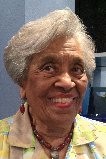 |
In our eyes, Mrs Odette Roy Fombrun is an historian, visionary, mother, grandmother, great grandmother, friend, colleague, educator and writer that holds her strength in her passion to create change in Haiti. The 94-year old woman is an amazing role model for so many. Her speech at the event ignited the fire in all of us to continue the positive work for our country. She truly spoke from the heart and the challenges she encountered in life. Overall, we need to remember according to Mrs Fombrun that we already have the resources in our motherland, and the key factor is to collaborate with others and seek the same goals instead of pursuing our individualistic goals for the betterment of Haiti.
It is a privilege for Haiti1Stop to feature Mrs Fombrum and we urge everyone to visit her website foundation and the various books and articles written by her. For information about her Foundation FORF, click here. For Mrs Fombrun’s profile, click here. To purchase her autobiography “Ma vie en Trois Temps” on her website, click here.
Haiti1Stop sends a special thank you to Mrs Odette Fombrun and Elsy Guibert, co-founder of EMG Health Communications. We hope you enjoy reading Mrs Fombrun’s insights on the questions we asked her in French and share them with friends and family. ~Dahla
Haiti1Stop: En quelques mots, parlez-nous de vous « Mme Odette » : l’adolescente, la femme dans ses vingtaines et la femme sage que vous êtes aujourd’hui?
Odette Fombrun: J’ai grandi dans une famille unie, nombreuse, bruyante, démocratique. Nous étions 11 enfants, plus un. Chacun jouissait du droit de s’exprimer librement. Les débat s’étaient donc très bruyants, mais se terminaient par un repas simple, typiquement haïtien, donc fait de pois et riz, bananes et patates, viandes en boulettes ou cuites en touffees de légumes.
Pour mes parents, la priorité était donnée à l’éducation, comme cela avait été le cas dans leurs familles, de génération en génération. D’où mes options en faveur de l’éducation. L’école normale terminée, j’ai fourni à l’Etat le service prévu en enseignant à une école publique située Place de la cathédrale. Mariée, mère de 5 enfants, j’ai suivi mon mari, Marcel Fombrun dans ses différentes missions ; puis en diaspora durant 27 ans.
Comme vous pouvez le constater, je ne suis pas féministe-activiste. C’est que chez nous il n’y avait pas de différences entre garçons et filles : nous avions tous mêmes droits, mêmes devoirs : la préséance était basée sur l’âge. Aussi, je lutte simplement pour l’égalité des sexes.
Haiti1Stop: Que voulez-vous que les gens sachent qui n’a pas encore été publié de vous?
Odette Fombrun: Je souhaite que l’on continue de dire ce que l’on a dit de bien de moi concernant mon nationalisme, mon combat incessant en faveur de l’éducation, surtout de l’éducation civique.
Haiti1Stop: Etant une modèle, quels sont vos conseils aux jeunes femmes d’aujourd’hui?
Odette Fombrun: Que notre histoire est pleine de femmes modèles ; de lire l’histoire de leurs vies, de leurs interventions dans tous les domaines où elles se sont illustrées : éducation, art, services sociaux …et de les imiter.
Haiti1Stop: Parmi tous les livres que vous avez écrits, lequel vous a le plus touché? Et pourquoi?
Odette Fombrun: Quand j’écris, je suis tout entière à ce que j’écris: rien d’autre n’existe. Cependant les livres qui m’ont donné le plus de soucis sont ceux qui concernent l’histoire, surtout celle du drapeau : j’entendais respecter la vérité historique, éviter la partisannerie.
Haiti1Stop: Avez-vous pensé à écrire une autobiographie?
Odette Fombrun: Je l’ai fait depuis très longtemps. C’est Ma vie en trois temps. (aux éditions Deschamps). Elle mériterait d’être complétée.
Haiti1Stop: En Février 1986, vous avez écrit sur le «Konbitisme». Qu’est-ce qui vous a poussé à aborder cette issue? Et comment pourriez-vous expliquer ce concept à quelqu’un qui n’a aucune idée du “Konbitisme” et ses avantages dans l’avancement économique d’Haïti?
Odette Fombrun: Au départ de Jean-Claude Duvalier, tout s’appelait KONBIT pour exprimer le désir des haïtiens de coopérer, de participer à la reconstruction des écoles démolies. En résume : de FAIRE ENSEMBLE. J’ai donc conclu que, au lieu de parler au peuple haïtien de communisme, de socialisme…, il fallait appeler notre contrat social national : konbitisme, un mot lakay qui a une résonnance de tam-tam, de participation, de coopération, donc de faire ensemble. Il est évident que de nos jours, le mot konbit signifie pour tout haïtien : faire quelque chose ensemble. Il est indispensable que les 3 Pouvoirs s’entendent et encouragent une grande konbit nationale au bénéfice du pays. C’est pourquoi j’invite la diaspora à se préparer à jouer sa participation dans cette konbite nationale, en commençant par donner son plein soutien au Touris lakay dont le but est le développement du monde rural.
Haiti1Stop: Quels sont vos points de vue sur le gouvernement d ‘Haïti pour stimuler son système de renseignement? Assurer la sécurité des gens? Et fournir un environnement favorable en termes d’abris pour ceux qui vivent encore sous des tentes.
Odette Fombrun: Concernant la sécurité, il faut renforcer les capacités de la Police nationale et créer davantage d’emplois, vu que de nombreux actes de violence sont dus à la misère. Le problème d’abris est en voie de résolution. Plusieurs sites sont débarrassés de tentes. Entre autres, les parcs de Pétion-Ville, la route de l’aéroport, une partie du champ-de-Mars…
Haiti1Stop: Croyez-vous qu’Haïti doit continuer de dépendre de la même constitution des années d’avant pour la gouvernance du pays?
Odette Fombrun: Je l’écris depuis longtemps : il nous faut une nouvelle constitution. Celle de 1987 n’a jamais pu être appliquée et pour causes. Nous proposons pour la nouvelle constitution le choix de la REGIONALISATION : toutes les forces de la région utilisées – y compris celles de la diaspora – dans l’exploitation de toutes ses richesses naturelles, culturelles et surtout historiques.
Haiti1Stop: Croyez-vous que la vraie démocratie peut exister en Haïti?
Odette Fombrun: Si je pensais qu’elle ne peut pas exister, je ne continuerais pas de lutter.
Haiti1Stop: Comment résoudre les problèmes concernant l’éducation ?
Odette Fombrun: Ils sont très difficiles à résoudre. J’ai beaucoup écrit sur ce sujet. Il ne peut pas être traité en quelques lignes.
Haiti1Stop: Votre organisation FORF fait un travail merveilleux en Haïti. Nous sommes conscients de votre engagement avec les grottes cachées existantes en Haïti, et nous aimerions savoir si elles peuvent vraiment être préservées pour les générations à venir et comment nous, en tant qu’individus pouvons contribuer à la préservation des lieux historiques d’Haïti?
Odette Fombrun: La FORF encourage autant qu’elle le peut les spéléologues enthousiastes, comme Carole Devilliers, haïtienne de cœur. Son groupe essaye d’organiser leur découverte et leur protection.
Vous pouvez aider en soutenant leurs efforts et en faisant du Touris lakay.
Haiti1Stop: Est-ce que vous pouvez partager avec nous votre meilleur trésor caché d’Haïti?
Odette Fombrun: Je dirais que nous avons des richesses uniques à exploiter. Par exemple, la Tortue qui a toute l’histoire de la flibuste, l’histoire des pirates. Si on y installait quelque chose dans le style Disney, les touristes s’y rendraient en masse.
Haiti1Stop: Dans vos mots poétiques, pourriez-vous expliquer la culture Taino Indienne en Haïti et son impact dans les racines haïtiennes?
Odette Fombrun: La FORF prépare un colloque sur les Tainos d’Haïti pour mars-avril 2013. Ceux qui ont des informations ou connaissent des personnes qui en ont sont priés de nous contacter pour participation à ce colloque. Ce patrimoine est à protéger et à exploiter. Demandez-vous pourquoi Dessalines, après des siècles de colonisation française a redonné son indien au pays ?
Haiti1Stop: Qui ou quoi vous a influencé le plus dans les décisions que vous prenez chaque jour ?
Odette Fombrun: Ma longue vie en milieux et pays différents de cultures, de coutumes ayant leurs valeurs propres. Mon expérience de 27 ans en diaspora haïtienne et, évidemment en priorité mes parents qui nous ont inculqué le sens du devoir civique, en mettant eux-mêmes leur pierre dans la construction du pays. Ainsi, mon père, Louis Roy, avait fondé l’Ecole des Sciences Appliquées pour formation d’ingénieurs et d’architectes. En visitant le MUPANAH, j’ai pu lire son nom gravé sur la pierre, prise du palais national, portant les noms des ingénieurs qui avaient participé à la construction de ce palais.
Haiti1Stop: Est-ce que votre Fondation, FORF a l’intention d’avancer dans les autres villes d’Haïti? Et quels sont les besoins actuels de la Fondation ?
Odette Fombrun: Avec les dons de mini bibliothèques aux écoles défavorisées, notre action n’a pas eu de limites. Actuellement, nous sommes engagés dans les séminaires pour jeunes pour le développement du Touris lakay qui a en vue le développement des communautés rurales, sans lequel il n’y a pas de salut pour Haïti. Nos besoins n’ont pas de limites. Plus nous recevrons d’aides, plus nous aiderons.
Haiti1Stop: Finalement, avez-vous des derniers mots de sagesse que vous aimeriez nous donner? Et comment voulez-vous que la génération actuelle et future utilise votre héritage?
Odette Fombrun: Je souhaite que toutes mes initiatives me survivent. Que mes nombreux livres scolaires, en histoire, géographie, sciences sociales, éducation civique, tant en français qu’en créole…; mes romans policiers pour enfants… mes articles de journaux, classés au bureau de la FORF, soient consultés et sources d’inspiration pour les jeunes.
FORF is also listed under our Local Organizations, and Education sections
Want to leave a comment? If so, please drop us a note on our Facebook page.
Posted on January 3, 2012
Haiti1Stop connects with CapraCare
Founded in April 2009, CapraCare is a non-profit community health organization that addresses the health concerns of the residents of Fonfrede, Haiti, by promoting school-based health programs, preventive health care, nutrition and mental health services and by working closely with neighboring schools and hospitals . They rely on their volunteers in Haiti and overseas to achieve their services and training. According to CapraCare, they stand as the only Haitian non-governmental organization in Fonfrede that provides access to preventive care and other medical necessities in the city. Everyone has access to their services regardless of their ability to pay. CapraCare needs committed individuals with different skills sets to support them in achieving their long term vision to a healthier community at Fonfrede.
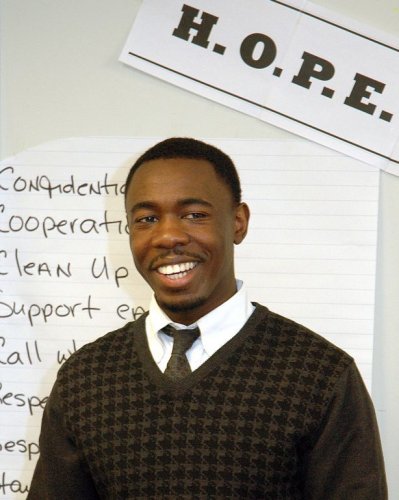 Haiti1Stop had the pleasure of connecting with the Founder/Executive Director of CapraCare, Jean Pierre-Louis, on their work at Fonfrede. Mr. Jean Pierre-Louis has been instrumental in putting CapraCare on the front line and has an endearing passion for the organization that he founded in 2009. After our initial contact with CapraCare, we felt compelled to feature this incredible organization in a Q&A format. Their exemplary work reflects how one person with a vision can make a difference through determination and hard work. Haiti1Stop would recommend everyone to read about CapraCare and support them either through monetary donations or volunteerism.
Haiti1Stop had the pleasure of connecting with the Founder/Executive Director of CapraCare, Jean Pierre-Louis, on their work at Fonfrede. Mr. Jean Pierre-Louis has been instrumental in putting CapraCare on the front line and has an endearing passion for the organization that he founded in 2009. After our initial contact with CapraCare, we felt compelled to feature this incredible organization in a Q&A format. Their exemplary work reflects how one person with a vision can make a difference through determination and hard work. Haiti1Stop would recommend everyone to read about CapraCare and support them either through monetary donations or volunteerism.
Below is a glance at CapraCare’s initiatives and positive work in Fonfrede. We will feature more of CapraCare in the future as we see this organization evolving.
Haiti1Stop: Does CapraCare intend to open a clinic in Fonfrede in the long run?
Jean Pierre: Yes, CapraCare plans to open a health clinic in Fonfrede that will be well equipped with a medical team that will provide health services such as physical examinations, dental, HIV testing and support, and more comprehensive health services to the community.
Haiti1Stop: Does the organization plan to extend its services to other areas of Les Cayes or in Haiti?
Jean Pierre: Yes, CapraCare is strategically planning to have our program implemented in as many communities throughout Haiti as resources allowed.
Haiti1Stop: How many individuals does CapraCare serve in a year with the types of services provided?
Jean Pierre: We provide services to approximately 1,500 people annually.
Haiti1Stop: How has the community responded to the health education and the psychological support specifically post earthquake?
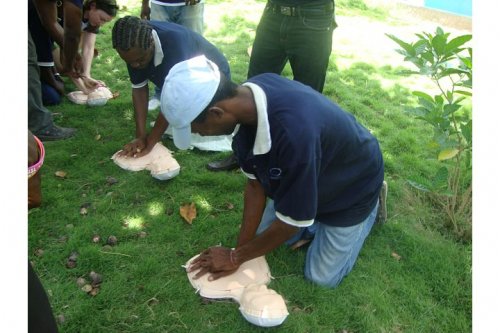
CPR Workshop |
Jean Pierre: The community has responded very well to our health education program. We find our participants are eager to learn about preventive health issues. They have been well attended with an average of 25-30 participants at the health education workshops and 125 – 150 participants at the community health fairs. We are working very hard to provide these services at the highest quality, enjoyable, and meaningful with the hope to receive support to conduct them at a higher frequency.
Haiti1Stop: Are people of Fonfrede open to the psychosocial program and does CapraCare have enough volunteers in this field?
Jean Pierre: At CapraCare, we believe there is no health without mental as a result it’s very important to provide mental health support. Prior to the Haiti earthquake, we found that people were not so receptive and didn’t understand the importance of mental health support as they kept referring to the stigmas associated with such service. However, immediately after the Haiti earthquake, it became the #1 service people were asking to receive from our program. And, since a lot of people still believe in some of the negative stigmas associated with mental health, CapraCare is using a community model and taking a traditional healing approach to provide such services; in addition, since the infrastructure of neither Haiti nor CapraCare has the capacity to support the more advance traditional western interventions such as psychotherapy, pharmacotherapy, etc, we believe our strategy will provide equally beneficial outcomes.
Haiti1Stop: Would you share with us which group (adults vs. children vs. elderly) has been more receptive to the mental health program?
Jean Pierre: The adults, children, and elderly all have been equally receptive at participating in our mental health supported services. We believe this because our program has been very creative and innovative with identifying activities to keep each group engaged. However, the children by far is a much bigger challenge to service since they require a lot more resources, monitoring, and closer supervision.
Haiti1Stop: What has been your biggest challenge in:
a) Starting such an endeavor in Fonfrede?
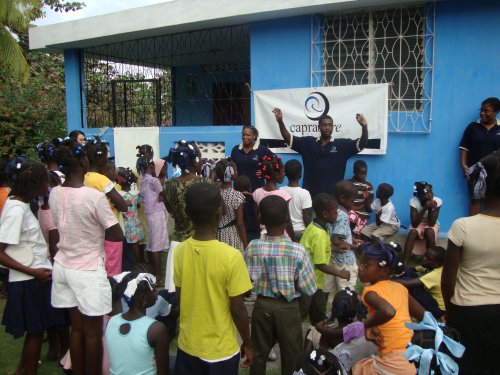 Jean Pierre: Fortunately for me, the challenges were not very difficult I was always connected to the community. As a child, I was very active in my community resulting in me becoming a very popular kid throughout the town. So, at 9 years old I was heartbroken after leaving Haiti, as I did not want to leave my community behind. And, since I couldn’t take my entire community with me, I always wanted to stay connected as I knew that connection would become extremely important for me to one day return with help to make life better for all of them.
Jean Pierre: Fortunately for me, the challenges were not very difficult I was always connected to the community. As a child, I was very active in my community resulting in me becoming a very popular kid throughout the town. So, at 9 years old I was heartbroken after leaving Haiti, as I did not want to leave my community behind. And, since I couldn’t take my entire community with me, I always wanted to stay connected as I knew that connection would become extremely important for me to one day return with help to make life better for all of them.
Haiti1Stop: b) Implementing the programs in the community of Fonfrede?
Jean Pierre: The community of Fonfrede embraces CapraCare as they know this is one of their own bringing help with no hidden motives or agenda. They trust CapraCare efforts and are very proud to be involved hands-on in its daily operation. So, implementing CapraCare’s programs is a matter of having the ability to continue receiving resources and support from caring individuals, courageous friends, and Haitian Diasporas community living abroad as the local community does not have the means to financially support CapraCare efforts.
Haiti1Stop: Is there a protocol to follow to become a CapraCare volunteer?
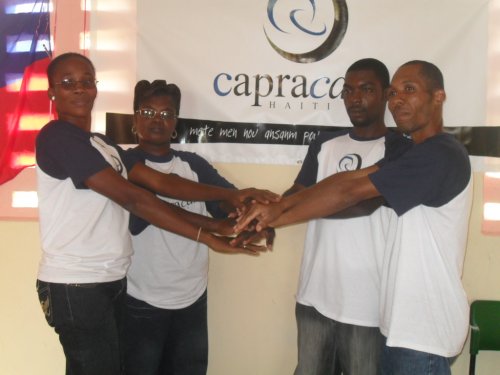 Jean Pierre: The protocol to becoming a CapraCare volunteer is simple. The person needs to express interest by informing us via email at info@capracare.org.
Jean Pierre: The protocol to becoming a CapraCare volunteer is simple. The person needs to express interest by informing us via email at info@capracare.org.
While we are eager to find volunteer help, we are careful when accepting the services you offer. If you contact CapraCare to offer to volunteer your time, you may be asked to come in for an interview, fill out a volunteer application, or describe your qualifications and your background just as you would at an interview for a paying job. It is in the organization’s interest and more beneficial to the people it serves to make certain you have the skills needed, that you are truly committed to doing the work, and that your interests match those of CapraCare.
We also offer virtual volunteering. If you have computer access and the necessary skills, we now offer the opportunity to do volunteer work over the computer. This might take the form of working on our website, multi-media, health curriculums, marketing, social networks, newsletter, translation, etc. This sort of volunteering might be well suited to you if you have limited time, no transportation, or a physical disability that precludes you from getting about freely. We work with college students as interns the same way.
Haiti1Stop: What is the minimum hours of commitment do you accept for the virtual volunteering? Again, anyone interested in participating should send an email to info@capracare.org?
Jean Pierre: We normally ask a minimum of six months commitment or we quantify the deliverable for the volunteer. For example, a person may volunteer 5+ hours a week; or the persons is a trainer and/or curriculum developer and is willing to provide CapraCare with two or three workshops. We try to be very flexible.
Yes, the first step is informing us that they are interested via email at info@capracare.org.
Haiti1Stop: What are CapraCare’s current needs?
Jean Pierre: CapraCare needs professionals to render their pro-bono services in the following areas: Grant writing, Marketing, Fundraising, Resource Developing, and Haitian Creole Translating. These needs will be ongoing as CapraCare continues to grow and expand to other parts of Haiti.
To contact Jean Pierre-Louis or send an inquiry to CapraCare for donations or volunteerism, send your inquiries to: info@capracare.org.
CapraCare is also listed under our Healthcare Education, Local/NGO, and Volunteer sections
Haiti1Stop extends their appreciation to Mr. Jean Pierre-Louis for providing us with pictures of CapraCare’s workshops as well as their partners’ contact information in Fonfrede. CapraCare has an upcoming fundraising event for Haiti on January 19th 2012.
Want to leave a comment? If so, please drop us a note on our Facebook page.
Posted on December 18, 2011
HCN Online Education in Haiti
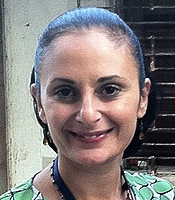 The Executive Director of the Haitian Connection Network (HCN), Kristen Hertzog, opens up about her non-profit organization, her love for Haiti, her family life, her passion and devotion to education, and her student sponsorship program. Kristen’s mission is to empower Haitian students and she is determined to provide them with the tools necessary for a great online education.
The Executive Director of the Haitian Connection Network (HCN), Kristen Hertzog, opens up about her non-profit organization, her love for Haiti, her family life, her passion and devotion to education, and her student sponsorship program. Kristen’s mission is to empower Haitian students and she is determined to provide them with the tools necessary for a great online education.
The conversation took place via Skype on Nov. 5th, 2011 at 1pm E.T. Our co-founder France had a wonderful time with Kristen and was fortunate to meet her lovely adopted daughter from Haiti. Please read on to learn how you can make a difference in a student’s life.
Haiti1Stop: When did you first learn about Haiti?
Kristen: I went to Haiti when I was 16 years old on a 10-day trip with a local church in my area. I am Italian-American and I knew nothing about Haiti. I thought, “This would be cool!”. So while I was in Cite-Soleil, a lady handed me her baby and ran away. I remember staring at this little girl in my arms. Her eyes were as big as life and she didn’t know what end was up. And I started screaming for this woman to take the baby back, saying “Come back! Come back”. Long story short, a member of the team found her, brought her to me, and I handed her the baby and she looked at me and said “I knew that you could give my daughter a better life in America”. And it felt like the clouds had parted, and I felt like God spoke to me and said “Kristen, one day, you are going to adopt a little Haitian girl”. And that stuck with me! Sixteen, what did I know? I cared about pimples and boys, not about adopting Haitian children! But that was so clear in my mind and sure enough, years and years later, I got married, and my husband and I decided to adopt a beautiful little Haitian girl. That is something that has been sort of a self-fulfilling prophecy, if you will in my life. So, there’s always been a connection to Haiti on a very deep level after that.
But, really, my yearly trips to Haiti didn’t begin until in 1999, when I was an adult. And I started leading short-term mission teams down to Haiti with a friend of mine. It was there that I met a young man by the name of Esperando. 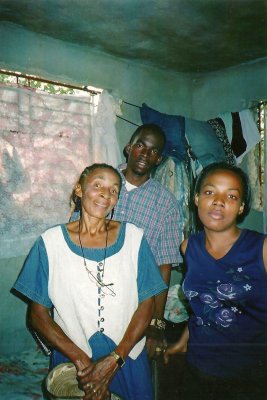 We were teaching conversational English at a school and this young man came up to me, and said “I need to quit High School this week, because I can’t afford to come here”. And with that, he took the button off of his shirt, rolled up his shirt, and he had all of these third degree burns, all over his arms. I said, “Oh my God, what happened to you?” He said “I have been working the graveyard shift at a plastics company and some of the plastic had spilled on my arm, and I was fired. And because of that, I can no longer afford to go to High School, “Is there anything you can do to help me?”. And myself and the team, we rounded up our souvenir money and we were able to send him the remainder of his High School education.
We were teaching conversational English at a school and this young man came up to me, and said “I need to quit High School this week, because I can’t afford to come here”. And with that, he took the button off of his shirt, rolled up his shirt, and he had all of these third degree burns, all over his arms. I said, “Oh my God, what happened to you?” He said “I have been working the graveyard shift at a plastics company and some of the plastic had spilled on my arm, and I was fired. And because of that, I can no longer afford to go to High School, “Is there anything you can do to help me?”. And myself and the team, we rounded up our souvenir money and we were able to send him the remainder of his High School education. 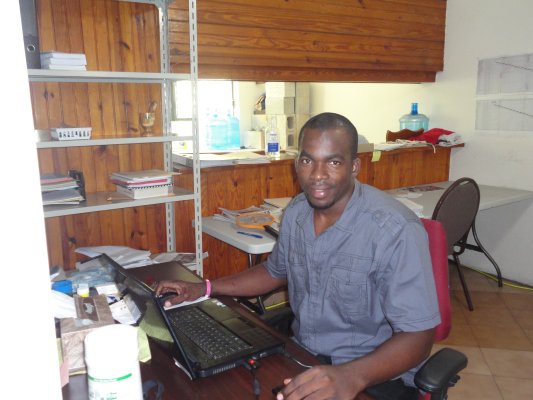 Since then, we developed a relationship, a friendship if you will, and after he graduated from High School, he asked me if we would send him to a computer college for two years. And, we were able to secure the funding for that. So long story short, 2004, this guy has barely eked out a High School diploma, he lives in a two-room shack, eats one meal a day, and has no plan B or A. By 2010, because of that two-year computer degree, this guy is now married, has two children, has his own home, is sending his brother to High School, helping his ailing parents, and is running a leading NGO in Haiti. That put a fire under my butt, and made me say “If there is a kid like that, there’s got to be more of them”.
Since then, we developed a relationship, a friendship if you will, and after he graduated from High School, he asked me if we would send him to a computer college for two years. And, we were able to secure the funding for that. So long story short, 2004, this guy has barely eked out a High School diploma, he lives in a two-room shack, eats one meal a day, and has no plan B or A. By 2010, because of that two-year computer degree, this guy is now married, has two children, has his own home, is sending his brother to High School, helping his ailing parents, and is running a leading NGO in Haiti. That put a fire under my butt, and made me say “If there is a kid like that, there’s got to be more of them”.
Haiti1Stop: So, in the span of 2004 to now, when did HCN get started?
Kristen: We became an official non-profit organization in 2009. And after that, we were able to secure a University partner to assist us in our quest. So, the way to think about HCN is HCN provides the infrastructure for online learning. We are not a University and we are not a school. We provide everything that a needy student needs to connect. For example, I had a meeting with Wyclef Jean about this very issue. And we were talking about the fact that having one laptop per child is a grand idea in a regular wealthy country. In Haiti, it’s like handing a kid a twelve pound rock. He can’t charge it, he doesn’t know how to fix it, and he doesn’t have internet access. So the laptop is pointless thing to give. The HCN Student Computer Center provides the energy, the backup power, the technical assistance and even one meal per student per day. So that they can be eating and able to concentrate on their online studies while they’re in school. So it provides all those things to make that education happen.
Haiti1Stop: How early do people have to apply to be part of the program?
Kristen: They have to have their High School diploma in hand. The current documentation that is necessary to be considered for HCN Student Computer Center and its partner, University of the People, are that students must read and understand fluent English. The reason why is because our University ally is in Pasadena, California. And therefore, because it is an American based non-profit tuition free education system, it is in English. Secondly, it must be notarized, legalized and translated into the English language as well as their High School transcript. From a documentation standpoint, those are the things that we require before we can go any further in the application or admission process.
HCN looks specifically for other things as well for acceptance into the Computer Center. We look for motivated kids, driven people, people who have had possibly very little assistance in any way in their lives, because of their home lives or financial situation. We look for those kids that we can say in our minds: “where are those kids going to be five years down the road, ten years down the road or is this kid going to show up for school, or is he going to get tired trying to find a tap-tap every day?” So it is a sacrifice on the part of the student, many students, just to get to the learning center. We definitely look for those kids that we know they are going to follow through. It’s not enough to say you want an education; it’s not enough to say you want a better life. You have to do what you have to do in order to make that occur, and I feel very passionately about that.
Haiti1Stop: HCN’s curriculum is Business Administration and Computer Science. Why did you pick these two as your curriculum? (Both of them are two-year associate degrees through the University of the People)
Kristen: Well, several reasons. Number one, they are currently the only ones that the University of the People offers our Haitian students tuition free at this time. And secondly, in my experience with local organizations and businesses on the ground in Haiti, these are two fields that are desperately needed in Haiti. So, I think of it as “HCN is building leaders and building techies”. And as Haiti rebuilds from the earthquake, these are two fields that are critical for success in Haiti’s employment, and economy and the financial sector.
Haiti1Stop: Walk me through a typical day for a student at HCN.
Kristen: Once a student is accepted into the University of the People, based upon availability, students can choose to come Monday through Friday for a morning shift or an afternoon shift. They must be on time, they must be on time, they must be on time! We have students who are coming from Carrefour and areas two hours away, they must be on time as well, so that’s critical. Students get four hours per day to be online, on an HCN laptop with printer, scanner access as needed.  And their responsibility is really self-motivated because every student in the school could be in a slightly different place in their education, based upon where they started. Then at 12 noon, the students will receive one meal per school day. So the morning shift is leaving and they get to eat, the afternoon shift is coming in and they get to eat so the students can have fellowship together, and talk with each other, and enjoy the meal, and continue on in their day. So it is definitely, a self motivated program, there is no one standing over you, making sure you are doing every last little thing. You must be driven to do it yourself or else you will not succeed.
And their responsibility is really self-motivated because every student in the school could be in a slightly different place in their education, based upon where they started. Then at 12 noon, the students will receive one meal per school day. So the morning shift is leaving and they get to eat, the afternoon shift is coming in and they get to eat so the students can have fellowship together, and talk with each other, and enjoy the meal, and continue on in their day. So it is definitely, a self motivated program, there is no one standing over you, making sure you are doing every last little thing. You must be driven to do it yourself or else you will not succeed.
The way that the University of the People is set up is that there is a lot of social media via text that happens throughout the course of the school day. So while a student might be in Haiti studying, perhaps the 20 people in his classroom virtually might be from all over the globe. It is very exciting for our students that the online learning experience has opened up their eyes to the way other people do [life] in other countries and how important and how global the world has become.
In addition to that, there are sometimes meetings with our administration on the ground in Haiti. We have workshops where American business people will come and talk to our students about various fields of study. We’ve had workshops on resume writing and interview skills. The students get to learn how to respond and relate to people and how to relate to someone who owns a company in Haiti where perhaps, they’ve never talked to anybody in their life who owns a business. The agenda is to really empower the students that they are an equal to the people. We try to give a very well rounded approach to the careers the students will eventually have.
Haiti1Stop: How many staff members do you have in Haiti?
Kristen: We have four full-time members and we have one lady who does the cooking for us. So, the Haitian Connection Network, the infrastructure is in place for additional students. We have someone who does recruitment, someone who does administration and we have technical assistance. For example, many of our students had never turned on a laptop before. You can’t expect them to go online and have no problem with learning the technology and having a learning curve. So we decided that a full time technical assistant was necessary. We have live security as well as computerized security. We have been completely, in my opinion, setup for this to grow, and that is the goal to see the organization grow and for more students able to come.
Haiti1Stop: Is there an opportunity for educators around the world willing to donate their time to HCN?
Kristen: At this time, no. Because University of the People is comprised of professors and folks who have pretty high academic standards. However, HCN is open to discussing with people who have an interest in possibly helping out educationally in other ways. For example, we are planning a trip in the Spring where educators from around the globe can come to HCN and do on the ground training with students. So it would give folks an opportunity to see what is really like down there, and who you are really affecting as well as to bring education as a more hands-on practical approach as opposed to online. People are more than willing to contact me about that at info@haitianconnectionnetwork.org.
Haiti1Stop: Do you have an ESL program for the students who do not know how to speak English?
Kristen: That is such an awesome question, because I can’t tell you how proud I am of our current students. I received two emails last week from our students who are volunteering to start ESL classes for the neighborhood. It shows that full self-motivation thing that I just get excited about. It’s one thing for things to be generated from the center, but it’s another thing for Haitians to be taking responsibility for their own future as well. I couldn’t be more thrilled. They are looking at doing two classes starting in the next few months, an advanced and intermediate English class. So, that will help those future students to get their English skills together, so when the time comes, they are ready and prepared with their High School diploma to go into the next step with us. We are also in negotiation with an online ESL training program. We may possibly be in the future opening our doors to additional ESL classes that will be virtual, in addition to the ESL classes the students want to put on.
Haiti1Stop: Where there any obstacles in building a partnership with the University of the People?
Kristen: Not really. I am very fortunate that the President of the University of the People, Mr Shai Reshef, and I were really on the same page with what we wanted to see happen with Haitian education. And last November 2010, a year ago, he flew in from Tel Aviv, Israel, and I flew in from Philadelphia and we met in Haiti with all of the students together. And, that was a wonderful experience for he and for myself. Some of the videos of our trip are on our website at www.haitianconnectionnetwork.org. You can actually see Mr. Reshef and myself, visiting the students’ home and talk to the students and it was really an inspiring time for both of us to have that very personal approach with the kids we were helping.
Haiti1Stop: Since HCN’s inception, what has been your graduation rate?
Kristen: That’s a grand question. We just started last year, last November with the two-year associate degree program through our partner, so we don’t have any graduates as of the moment because they are halfway through their education. However, we did pilot the HCN educational program in 2004 with 7 students. And all of them, we are very thrilled to say, are currently employed. I believe that education is a means to employment. I think that is a very mind bending idea to some. In my experience, education is revered in Haiti. For those potential students out there, where if someone were to ask you five years down the road, “where do you want to be”, and you say I still want to be in school, that’s a struggle. School, upon school, upon school is great, but it does not feed your stomach; education and employment does. So, we really search out for those students who look at themselves and say, I understand education is means to employment. And that is where our past students have been as well as our current students, halfway through this program.
Haiti1Stop: Where have your graduates gone to work?
Kristen: We have one working for an international NGO, one who is teaching English classes at a school, another who works in data entry for a local bank and others work in translation or teaching type of jobs.
Haiti1Stop: The ratio of women in technology is low, even in the U.S. How does the ratio of women vs. men students compare in the HCN computer science classes?
Kristen: Loaded question. I currently have 20 students. And I believe 20% are women and we are dedicated to finding female students who can qualify. I for one, as a woman[who] is very passionate about this because essentially in Haiti, the percentage of High School graduates, male to female is significantly lower. So that is my passion and my goal to see a 50-50 percentage rate male to female at HCN.
Haiti1Stop: Tell me more about your feeding program at HCN.
Kristen: We were finding that many of our students because of their economic situation were coming to school with headaches, and really struggling to focus and concentrate. And through a very generous donor, we have been able to provide this feeding program: one meal per day per student. I do want to emphasize that this agreement was for a year, and that year will end at the end of February 2012. For those who might be interested in helping to support us to continue that feeding program, they can contact us at www.haitianconnectionnetwork.org.
Haiti1Stop: In addition to that, what are HCN’s needs?
Kristen: The tuition is free; I want to make that real clear. University of the People is a tuition-free online University. Any Haitian, any Chinese person, any African person, any American, if they qualify, they can go tuition-free to University of the People. In Haiti, having those internet options, energy option, technical assistance, that’s where we come in and we are the vehicle to get the student that free education. Our costs per student are $1,600 US dollars per year and that includes all of the infrastructure costs necessary to get the kids the education through University of the People or any educational online program out there.
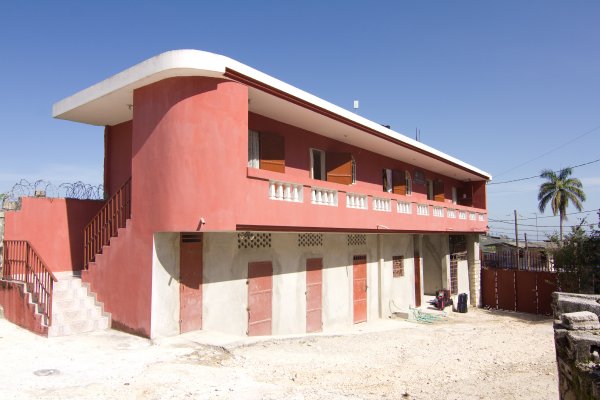 Currently, we have about 60 students pre-qualified and on a waiting list. What that means is we need the funding now to get them into the program. So, really, there are two kinds of folks that should really be hearing this message. The first one is that potential student who knows that they can afford through some means, whether through family, friends, or a job to afford the $1,600 US dollars per year, for a two-year associate degree. The other person is the potential donor who is listening and going, “My God, this has such long term benefits, I want to help fund a waiting student”. Those folks also should know that there is no waste in this program. That $1,600 is just a vehicle to get those students what they need so we need financial assistance, plain and simple. We need help and need people who believe in education, believe in Haiti, believe that education is the means to gainful employment — those are the people we want to talk to as soon as possible.
Currently, we have about 60 students pre-qualified and on a waiting list. What that means is we need the funding now to get them into the program. So, really, there are two kinds of folks that should really be hearing this message. The first one is that potential student who knows that they can afford through some means, whether through family, friends, or a job to afford the $1,600 US dollars per year, for a two-year associate degree. The other person is the potential donor who is listening and going, “My God, this has such long term benefits, I want to help fund a waiting student”. Those folks also should know that there is no waste in this program. That $1,600 is just a vehicle to get those students what they need so we need financial assistance, plain and simple. We need help and need people who believe in education, believe in Haiti, believe that education is the means to gainful employment — those are the people we want to talk to as soon as possible.
Haiti1Stop: What have been your biggest struggles in doing what you do with HCN besides financial needs?
Kristen: I think self-empowerment has been a challenge. Because so many Haitians have been through so much in the last few years, and historically, it’s unprecedented, the historical challenges that Haiti has had among so many other countries. I think that there is a sense of feeling beat down, and one of the things that I feel very passionate about as the Executive Director of HCN is to empower the students personally. It is a mind shift for many students who come from economically disadvantaged homes who have been told they’ll never go to college, have never dreamed of being employed gainfully, and actually getting a steady paycheck. They know no one else who’s ever done that.
The mind shift is very challenging and it is something that I personally feel passionate about. I had an interesting situation happen recently. I was down in Haiti, teaching a how to interview workshop with our students, and I asked one of the students to stand up, and pretend that I am a wealthy employer, and they are coming in for a job. And this brand new student who barely knew I was, stood up and very shakily put his hand out to shake my hand and looked down, he was afraid to look me in the eye. And I made him look at me. And I said to him, you are worth it, you are worth this job, and don’t let any history, don’t let any family, don’t let anybody tell you differently. The fact that you have gotten this far proves that you are worthy. This young man got a little emotional about that, and I think that struck a chord. And as a parent of a Haitian child, as well as biological child, I want my kids to feel empowered. I want them to feel like they can do anything and I want my Haitian students to feel the same way.
Haiti1Stop: As far as growth, would you like to expand HCN outside of Port-au-Prince?
Kristen: Oh my word, yes. I would love to have multiple centers in all of Haiti, in every region and city. Within the next five years, I would like to have several learning centers throughout the country. So, we are excited about where this can go. We are still in the baby stages so we have to make the funding work before we can get to that stage.
Haiti1Stop: How can someone sponsor a student at HCN?
Kristen: We have something going on right now called four for forty, [which means] 4 people committing $40 dollars a month for a year, equals one waiting student’s tuition. My husband and I went out for dinner the other night, it was over $40 dollars, just to go to a middle of the road restaurant and have dinner. If there were four people out there, who said, you know what, I can eat at home one night a month, and have 40 dollars to give towards a waiting student, that would be great. That’s the first way that someone can tangibly make a difference in the life of one of these students.
The students are ready to go, they are waiting for the phone call to say we have the funding for you and can you start on XYZ date. That’s the most tangible way that you can help out. We are a 501c3 and you can get your tax write-off. This is something that is critical because it has longevity and sustainability. We’d also love to talk to in person or on video Skype to see how people might be able to help HCN. Giving cannot be easier, on the HCN website, you can give right online through Egiving. You can do automatic deductions from your credit, checking or debit card every month. It’s a one- time setup, and every month $40 are deducted from your account, and that money goes directly to the Haitian Connection Network Computer Center for the new student.
Haiti1Stop: What is the last thing you want to leave us with?
Kristen: Right now, 20 kids are enrolled and 60 are on a waiting list. HCN is set up for additional students. We have the laptops, space, security, administration, technical support. What is missing is $1,600 per year per student for a two-year commitment. We need funds to support [our] infrastructure to support the students’ education.
To contact Kristen Hertzog on how to contribute to HCN’s feeding program or to sponsor a student, please forward your inquiries to: info@haitianconnectionnetwork.org.
HCN is also listed under our Education section and Sponsor a child section
For information on the University of the People, click here.
Want to leave a comment? If so, please drop us a note on our Facebook page.

 Haiti1Stop had the pleasure of connecting with the Founder/Executive Director of CapraCare, Jean Pierre-Louis, on their work at Fonfrede. Mr. Jean Pierre-Louis has been instrumental in putting CapraCare on the front line and has an endearing passion for the organization that he founded in 2009. After our initial contact with CapraCare, we felt compelled to feature this incredible organization in a Q&A format. Their exemplary work reflects how one person with a vision can make a difference through determination and hard work. Haiti1Stop would recommend everyone to read about CapraCare and support them either through monetary donations or volunteerism.
Haiti1Stop had the pleasure of connecting with the Founder/Executive Director of CapraCare, Jean Pierre-Louis, on their work at Fonfrede. Mr. Jean Pierre-Louis has been instrumental in putting CapraCare on the front line and has an endearing passion for the organization that he founded in 2009. After our initial contact with CapraCare, we felt compelled to feature this incredible organization in a Q&A format. Their exemplary work reflects how one person with a vision can make a difference through determination and hard work. Haiti1Stop would recommend everyone to read about CapraCare and support them either through monetary donations or volunteerism.
 Jean Pierre: Fortunately for me, the challenges were not very difficult I was always connected to the community. As a child, I was very active in my community resulting in me becoming a very popular kid throughout the town. So, at 9 years old I was heartbroken after leaving Haiti, as I did not want to leave my community behind. And, since I couldn’t take my entire community with me, I always wanted to stay connected as I knew that connection would become extremely important for me to one day return with help to make life better for all of them.
Jean Pierre: Fortunately for me, the challenges were not very difficult I was always connected to the community. As a child, I was very active in my community resulting in me becoming a very popular kid throughout the town. So, at 9 years old I was heartbroken after leaving Haiti, as I did not want to leave my community behind. And, since I couldn’t take my entire community with me, I always wanted to stay connected as I knew that connection would become extremely important for me to one day return with help to make life better for all of them. Jean Pierre: The protocol to becoming a CapraCare volunteer is simple. The person needs to express interest by informing us via email at info@capracare.org.
Jean Pierre: The protocol to becoming a CapraCare volunteer is simple. The person needs to express interest by informing us via email at info@capracare.org. The Executive Director of the Haitian Connection Network (HCN), Kristen Hertzog, opens up about her non-profit organization, her love for Haiti, her family life, her passion and devotion to education, and her student sponsorship program. Kristen’s mission is to empower Haitian students and she is determined to provide them with the tools necessary for a great online education.
The Executive Director of the Haitian Connection Network (HCN), Kristen Hertzog, opens up about her non-profit organization, her love for Haiti, her family life, her passion and devotion to education, and her student sponsorship program. Kristen’s mission is to empower Haitian students and she is determined to provide them with the tools necessary for a great online education. We were teaching conversational English at a school and this young man came up to me, and said “I need to quit High School this week, because I can’t afford to come here”. And with that, he took the button off of his shirt, rolled up his shirt, and he had all of these third degree burns, all over his arms. I said, “Oh my God, what happened to you?” He said “I have been working the graveyard shift at a plastics company and some of the plastic had spilled on my arm, and I was fired. And because of that, I can no longer afford to go to High School, “Is there anything you can do to help me?”. And myself and the team, we rounded up our souvenir money and we were able to send him the remainder of his High School education.
We were teaching conversational English at a school and this young man came up to me, and said “I need to quit High School this week, because I can’t afford to come here”. And with that, he took the button off of his shirt, rolled up his shirt, and he had all of these third degree burns, all over his arms. I said, “Oh my God, what happened to you?” He said “I have been working the graveyard shift at a plastics company and some of the plastic had spilled on my arm, and I was fired. And because of that, I can no longer afford to go to High School, “Is there anything you can do to help me?”. And myself and the team, we rounded up our souvenir money and we were able to send him the remainder of his High School education.  Since then, we developed a relationship, a friendship if you will, and after he graduated from High School, he asked me if we would send him to a computer college for two years. And, we were able to secure the funding for that. So long story short, 2004, this guy has barely eked out a High School diploma, he lives in a two-room shack, eats one meal a day, and has no plan B or A. By 2010, because of that two-year computer degree, this guy is now married, has two children, has his own home, is sending his brother to High School, helping his ailing parents, and is running a leading NGO in Haiti. That put a fire under my butt, and made me say “If there is a kid like that, there’s got to be more of them”.
Since then, we developed a relationship, a friendship if you will, and after he graduated from High School, he asked me if we would send him to a computer college for two years. And, we were able to secure the funding for that. So long story short, 2004, this guy has barely eked out a High School diploma, he lives in a two-room shack, eats one meal a day, and has no plan B or A. By 2010, because of that two-year computer degree, this guy is now married, has two children, has his own home, is sending his brother to High School, helping his ailing parents, and is running a leading NGO in Haiti. That put a fire under my butt, and made me say “If there is a kid like that, there’s got to be more of them”.  And their responsibility is really self-motivated because every student in the school could be in a slightly different place in their education, based upon where they started. Then at 12 noon, the students will receive one meal per school day. So the morning shift is leaving and they get to eat, the afternoon shift is coming in and they get to eat so the students can have fellowship together, and talk with each other, and enjoy the meal, and continue on in their day. So it is definitely, a self motivated program, there is no one standing over you, making sure you are doing every last little thing. You must be driven to do it yourself or else you will not succeed.
And their responsibility is really self-motivated because every student in the school could be in a slightly different place in their education, based upon where they started. Then at 12 noon, the students will receive one meal per school day. So the morning shift is leaving and they get to eat, the afternoon shift is coming in and they get to eat so the students can have fellowship together, and talk with each other, and enjoy the meal, and continue on in their day. So it is definitely, a self motivated program, there is no one standing over you, making sure you are doing every last little thing. You must be driven to do it yourself or else you will not succeed.  Currently, we have about 60 students pre-qualified and on a waiting list. What that means is we need the funding now to get them into the program. So, really, there are two kinds of folks that should really be hearing this message. The first one is that potential student who knows that they can afford through some means, whether through family, friends, or a job to afford the $1,600 US dollars per year, for a two-year associate degree. The other person is the potential donor who is listening and going, “My God, this has such long term benefits, I want to help fund a waiting student”. Those folks also should know that there is no waste in this program. That $1,600 is just a vehicle to get those students what they need so we need financial assistance, plain and simple. We need help and need people who believe in education, believe in Haiti, believe that education is the means to gainful employment — those are the people we want to talk to as soon as possible.
Currently, we have about 60 students pre-qualified and on a waiting list. What that means is we need the funding now to get them into the program. So, really, there are two kinds of folks that should really be hearing this message. The first one is that potential student who knows that they can afford through some means, whether through family, friends, or a job to afford the $1,600 US dollars per year, for a two-year associate degree. The other person is the potential donor who is listening and going, “My God, this has such long term benefits, I want to help fund a waiting student”. Those folks also should know that there is no waste in this program. That $1,600 is just a vehicle to get those students what they need so we need financial assistance, plain and simple. We need help and need people who believe in education, believe in Haiti, believe that education is the means to gainful employment — those are the people we want to talk to as soon as possible.



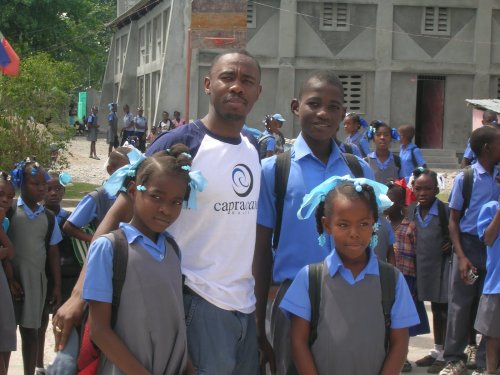

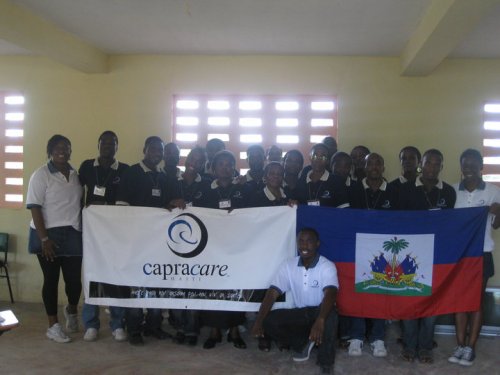
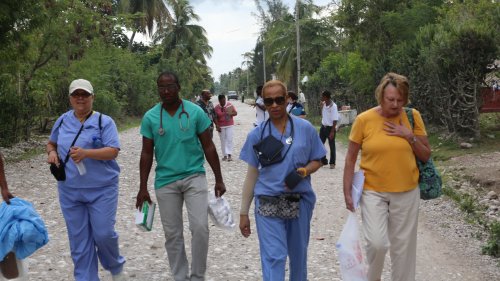


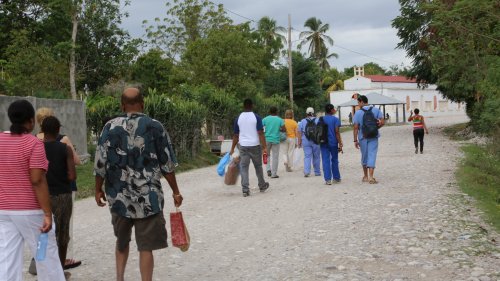







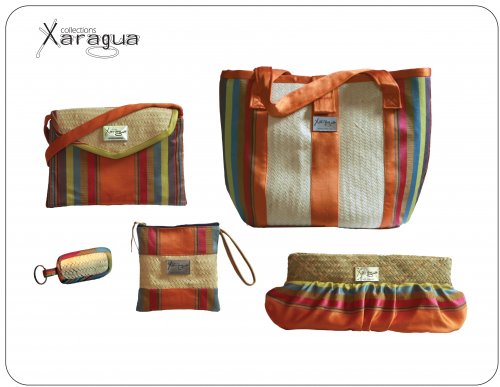
 Haiti1Stop: Did you encounter any roadblock/challenges in starting your collection and opening your company in Haiti? If yes, describe them. And, what will be your best advice to aspiring entrepreneurs?
Haiti1Stop: Did you encounter any roadblock/challenges in starting your collection and opening your company in Haiti? If yes, describe them. And, what will be your best advice to aspiring entrepreneurs? 